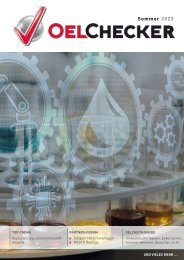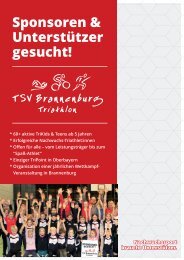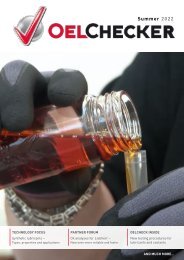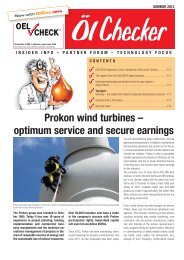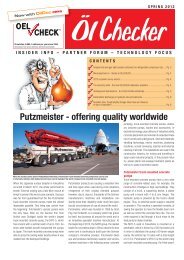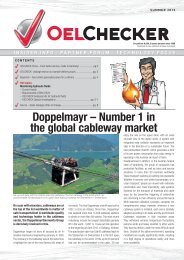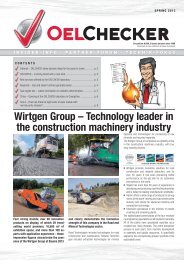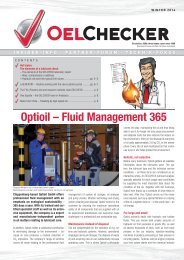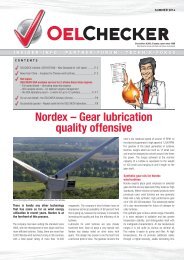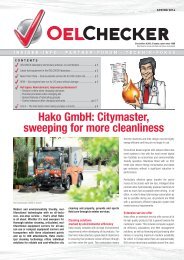OELCHECKER - Winter 2012
> OELCHECK China – Getting ready before the new laboratory opens > OELCHECK Laboratory – quicker and more accurate with a new particle counter > Hot Topics: The analysis of lubricating greases > Correct sampling > Most important analysis methods > Experience of our experienced tribologists > In demand – optimising online documentation of laboratory reports > and much more...
> OELCHECK China – Getting ready before the new laboratory opens
> OELCHECK Laboratory – quicker and more accurate with a new particle counter
> Hot Topics: The analysis of lubricating greases
> Correct sampling
> Most important analysis methods
> Experience of our experienced tribologists
> In demand – optimising online documentation of laboratory reports
> and much more...
Create successful ePaper yourself
Turn your PDF publications into a flip-book with our unique Google optimized e-Paper software.
Now with OilDoc news<br />
WInTEr <strong>2012</strong><br />
Circulation: 9,000, 3 editions per year since 1998<br />
Download at www.oelcheck.de/news downloads<br />
InsIdEr InfO · PArTnEr fOrUM · TECHnOLOGY fOCUs<br />
COnTEnTs<br />
OELCHECK China – Getting ready before the new laboratory opens ........ P.2<br />
OELCHECK Laboratory – quicker and more accurate<br />
with a new particle counter ................................................................... P.3<br />
Hot topics:<br />
The analysis of lubricating greases<br />
– Correct sampling<br />
– Most important analysis methods<br />
– Experience of our diagnostic engineers ...........................................P. 4-8<br />
In demand – optimising online documentation of laboratory reports ........ P.8<br />
from dietenhofen to all over the<br />
world – the triumph of PLAYMOBIL<br />
While more than 50 per cent of the toys available<br />
in Germany come from the far East,<br />
geobra Brandstätter GmbH & Co. KG, better<br />
known as the manufacturer of PLAYMOBIL,<br />
has its own production sites in Germany<br />
and Europe. The first toy Indians, builders<br />
and knights marched their way into children‘s<br />
bedrooms all over the world in 1974.<br />
There have been over 3,700 different toy<br />
figures produced since then and the PLAY-<br />
MOBIL figurine population has reached 2.5<br />
billion. Joined together hand-in-hand they<br />
would stretch around the Earth 3.1 times.<br />
The beating heart of the company‘s production is in<br />
the Franconian village of Dietenhofen in the district<br />
of Ansbach. 1,200 employees work here. Every day,<br />
443 injection moulding machines spray up to<br />
10 million individual components, 250,000 pieces are<br />
pressed and an average of 65,000 PLAYMOBIL sets<br />
are packaged. In 2011, geobra dispatched a record<br />
number of 55 million finished items. To achieve these<br />
impressive production figures, shift workers operate<br />
the moulding machines around the clock. The seven<br />
spraying halls are equipped with first-class machines<br />
from Arburg, Babyplast, Battenfeld, Boy, Ferromatik,<br />
Sumitomo Demag, Engel and Krauss Maffei. Even<br />
the smallest pieces of equipment have a clamping<br />
force of six tons; the biggest have a force of between<br />
250 and 2,000 tons. Soon even larger machines used<br />
by Brandstätter to make high-quality planters bearing<br />
the brand name LECHUZA will become operational.<br />
The hydraulics systems in the modern injection moulding<br />
machines are compact and particularly highperformance.<br />
Reduced gap tolerances and improved<br />
quality of surfaces enable extremely high working<br />
pressures with high clamping force and incredibly<br />
precise working system components. In Dietenhofen,<br />
a specialist hydraulics department maintains the<br />
hydraulic systems of the 443 injection moulding machines.<br />
Eight engineers and five electricians carry out<br />
routine checks based on the guidelines provided by<br />
the individual manufacturers at 500-hour intervals.<br />
Additionally, extensive annual maintenance work is<br />
carried out after 5,000 operating hours, sometimes<br />
more frequently. Depending on their make, the hydraulic<br />
systems operate with between 12 and 3,000 litres<br />
of hydraulic oils, type HLP 46, in accordance with DIN<br />
51524 T-2. These are predominantly conventional<br />
mineral-oil based hydraulic oils with ZnDTP-based<br />
additives. Zinc-free HLP 46 is only used if specified<br />
by the machine manufacturer. On the whole, geobra<br />
keeps the range of lubricants and hydraulic oils it uses<br />
to an absolute minimum to avoid mixing up oils, e.g.<br />
during additional bypass filtration.<br />
Maintaining and monitoring hydraulic oils is vital to<br />
the running of the machines. It is not uncommon for
There cannot be many people who were not enthralled by Felix<br />
Baumgartner‘s space jump. Even though the project had been<br />
planned down to the smallest detail it could still have gone<br />
wrong. When he went into a tailspin shortly after jumping, disaster<br />
did not seem far off. What drives someone to embark on such<br />
risky adventures? Courage, an iron will and a daredevil streak are<br />
all reasons why he jumped from a height of 39 kilometres. Felix<br />
Baumgartner will be provided for financially until his old age. But<br />
money alone was certainly not the driving force behind his jump.<br />
What probably decided it for him was the unique thrill of pushing<br />
the boundaries of human experience.<br />
But do we really need to push ourselves to the limit like that? Aren‘t people who can live without<br />
such experiences better off? What does an extreme sportsman feel afterwards, and after his<br />
greatest triumph? Does an emptiness spread through him which can only be filled by the next<br />
challenge? What will happen at the end of his career? Does he still live for that day and live on his<br />
fame from days past? Or has he already found a new fulfilling task?<br />
Everyone deserves a fulfilling life with a job that they love. Not everyone can have a life in the<br />
fast lane. However, not everyone can get used to the humdrum regularity of everyday life. We at<br />
OELCHECK manage both. We are constantly looking to expand and are devoting all our energies<br />
to this. We never give up – again and again we take on big and small challenges alike. It has been<br />
a pleasure to work for you for over 20 years now.<br />
Yours, Barbara Weismann<br />
In Dietenhofen, 443 injection moulding machines produce up to<br />
10 million single parts daily.<br />
a machine to operate for over 35,000 hours without<br />
oil changes. Fresh oil, which does not always meet<br />
the required purity levels because it has been transported<br />
and stored, only enters the machine after it<br />
has passed through an upstream fine filter. Many machines<br />
are also equipped with a bypass filter. The hydraulic<br />
oils in machines which use very large quantities<br />
of oil undergo bypass filtration through supplementary<br />
filters. The inspection of used oils to check for mixing<br />
or pollution is carried out according to the manufacturer<br />
specifications and includes on-site testing and<br />
OELCHECK analyses.<br />
Before each major hydraulic oil change, standard<br />
procedure is to carry out a large-scale analysis of the<br />
oil in the OELCHECK laboratory. Only by doing this<br />
can the need to change the oil be confirmed. Among<br />
other things, the process closely examines oil ageing.<br />
High temperatures, long service lives, high pressure<br />
and in some cases even wear particles all accelerate<br />
the inevitable ageing process. If the hydraulic oil is not<br />
performing at a satisfactory level and the oil‘s viscosity<br />
has changed as well, this will have a direct effect<br />
on the efficiency of the pump first and foremost. The<br />
build-up of pressure required to operate the injection<br />
moulding machine is no longer present and the tendency<br />
for cavitation of the oil increases. The air output<br />
capability deteriorates. The hydraulic fluid must then<br />
be changed.<br />
Early damage detection is a further invaluable benefit<br />
of the analysis. If, for instance, the laboratory report<br />
shows increased levels of the wear metals iron, chromium,<br />
tin, copper or lead, targeted action can find<br />
the components from which the metals originate.<br />
Of course, the oils are also analysed for possible<br />
cool water leakage because too much water in oil<br />
can damage the pumps. With OELCHECK analyses,<br />
geobra can rest assured that there will be no delays<br />
to production and no children will be deprived of their<br />
beloved PLAYMOBIL figures.<br />
OELCHECK China<br />
Getting ready before<br />
the new laboratory opens<br />
Intensive training in Brannenburg for<br />
our new Chinese employees<br />
Only a few weeks remain before our laboratory<br />
in Guangzhou in southeast China is opened. All of the<br />
lab equipment for the Chinese laboratory was built<br />
in Brannenburg. Nicholas Liu Ke, Andrew Zeng An<br />
and William Wang Wei Dong (see photo above with<br />
Paul Weismann, from left to right) have got to know<br />
how the procedures and equipment work under the<br />
tutelage of our scientific director, Dr Thomas Fischer.<br />
Laboratory manager William Wang Wei Dong has<br />
a Bachelor‘s degree in lubricants and tribology and<br />
has already set up and successfully managed a lubricant<br />
analysis laboratory in China. Andrew Zeng An,<br />
a mechanical engineer, has been writing up Chinese<br />
laboratory results for 10 years. With his vast technological<br />
know-how, he will be responsible for sales and<br />
marketing and will answer inquiries made by Chinese<br />
customers. Nicholas Liu Ke has a Bachelor‘s degree<br />
in engineering. He will assume responsibility for the<br />
intake of specimens, operation of laboratory equipment<br />
and communication in English. These three<br />
employees will be supported by additional laboratory<br />
technicians, other specialised technical staff and an<br />
accountancy team.<br />
During the training in Brannenburg, all the testing<br />
equipment was set up and linked to the central server<br />
in exactly the same way as it will be in Guangzhou. After<br />
all, everything must run as smoothly and work as perfectly<br />
as in the original laboratory in the spring. However,<br />
the results will be assessed and a full diagnosis will<br />
take place in Germany. The values recorded in China<br />
will be transferred to the Brannenburg database via the<br />
internet. There they will be assessed by the diagnostic<br />
engineers in the same way as if the specimens came<br />
from Germany. Regardless of which country the sample<br />
was investigated in and where our customers are<br />
from, the following requirement is always applicable:<br />
the laboratory reports must be available worldwide on<br />
our internet platform www.laborberichte.com within<br />
48 hours. It goes without saying that this is available in<br />
15 different languages, including Chinese!
OELCHECK Insider Info<br />
The OELCHECK laboratory -<br />
quicker and more accurate with a new particle counter.<br />
Almost 80% of all hydraulic failure<br />
can be traced back to impure oil. In<br />
order to lubricate other components,<br />
which are produced with an increasing<br />
level of precision, the purity and<br />
cleanliness of oil is of increasing importance.<br />
In order to better predict<br />
how much longer oil can be used for,<br />
the particle count of over 600 oil samples<br />
is carried out in the OELCHECK laboratory<br />
on a daily basis. The four counting<br />
systems, which are equipped with specimen<br />
change-over facilities, often run<br />
at full capacity, which is why we have<br />
installed an additional innovative particle<br />
counter. It has not just made the<br />
work of the laboratory technicians easier,<br />
but has also sped up work flow.<br />
Impurities in oil can always be a risk. Hard particles<br />
such as dust, coloured particles and wear metals<br />
can cause abrasive wear. Soft particles can build<br />
up from old additive components. Often they are<br />
adhesive too and stick to machine parts or filters,<br />
which prevent them from functioning smoothly.<br />
Particles in oil accelerate the ageing of oil and<br />
shorten its lifespan.<br />
Particle counting and<br />
optical particle analysis<br />
Particularly when checking hydraulic, turbine and<br />
other low-viscosity oils, the pollution level is determined<br />
based on ISO 4406 by counting the size and<br />
number of particles in the laboratory with help from<br />
automatic particle counters (APC). The level of pollution<br />
is divided up into purity categories. Here, laser<br />
sensors are used to determine the number and size<br />
of the particles. After the particles are counted,<br />
the oil is classified according to purity. The processes<br />
used to determine oil purity and purity categories<br />
are defined under ISO 4406 and SAE 4059.<br />
ISO 4406 classification is based on particle sizes<br />
>4 µm, >6 µm and >14 µm. The ISO particle numbers<br />
are cumulative, which means that the stated<br />
particle figure for > 6 µm consists of all particles<br />
>6 µm plus particles >14 µm.<br />
Detailed information about purity categories can<br />
be found at www.oelcheck.de under Downloads,<br />
ÖlChecker, Summer 2000, pages 6-7.<br />
Conventional particle counting only distinguishes<br />
between the size and number of particles, however.<br />
It does not record whether they are soft or hard<br />
particles. Water droplets, small air bubbles and<br />
The innovative particle counter in the OELCHECK laboratory already offers clear-cut advantages.<br />
soft particles are thus recorded too. OPA, optical<br />
particle analysis, provides more precise information<br />
on gear oils. It also photographs the outline of<br />
particles and divides them into specific categories<br />
such as wear fatigue, cutting wear, non-metal impurities<br />
(tribopolymers), water droplets and so on.<br />
The number and size of particles are recorded during<br />
the particle counting process too.<br />
The new particle counter offers<br />
distinct advantages<br />
In principle, the new generation particle counter<br />
in the OELCHECK laboratory works like existing<br />
devices with a laser sensor, but the samples<br />
are now homogenised and prepared better. The<br />
entire process has been simplified and optimised.<br />
In the conventional particle counting process,<br />
air bubbles and water droplets can influence the results.<br />
The new device rules out this possibility in the<br />
majority of cases.<br />
Particle counting is one of the first stages of analysis<br />
an oil sample undergoes. Previous machines<br />
analysed the sample directly from the original<br />
container. As counting can take up to 5 minutes,<br />
this may lead to delays further along the testing<br />
process, because too many samples get backed up<br />
as they wait to be counted. Now laboratory assistants<br />
pour only 20 ml approximately of the homogenised<br />
sample into a plastic beaker, which goes into<br />
the new counter. Afterwards the sample container<br />
is immediately transferred to the next examination<br />
stage, which of course reduces processing times.<br />
Instead of only 20 samples, the new device can<br />
be loaded with 80 sample containers. Before the<br />
actual counting, an innovative ultrasound sensor<br />
determines the exact size of the sample so that<br />
an exact solvent mixture of 75% toluene and<br />
25% propanol at a ratio of 2:1 (based on ASTM<br />
D7647-10) can be used and this can be taken into<br />
account to determine a blind value. Immediately<br />
before the measurement, the sample is homogenised<br />
and degassed. Air bubbles escape quickly<br />
from the diluted sample and can therefore no<br />
longer be counted in the analysis. The effect of<br />
the propanol in the solvent mixture is that possible<br />
water droplets dissolve and become „invisible“.<br />
In addition, the toluene dissolves any soft reaction<br />
products which may be present and ensures that<br />
only the hard particles which are actually present in<br />
the oil are counted.<br />
The entire diluted sample of around 30 ml is then<br />
counted three times in a row, from which a mean<br />
average is extrapolated. If the individual values differ<br />
from each other greatly, the particle counter rejects<br />
the whole analysis and requests a new specimen.<br />
It doesn‘t get much more precise than that!<br />
A Canadian company is behind our new particle<br />
counter. The core of the machine, the particle<br />
sensor, comes from Markus Klotz GmbH. In<br />
the OELCHECK laboratory, the innovative particle<br />
counter has already proven itself to be highly<br />
effective. Each day it looks at some 250 samples<br />
and is set to be joined by a second device of the<br />
same make soon.<br />
3
HOT TOPICs:<br />
OELCHECK TECHnOLOGY fOCUs<br />
The analysis of lubricating greases<br />
What lubricates more efficiently, oil or grease? Over 95% of all components are lubricated with oil, not because it lubricates better<br />
but because it has a wider variety of characteristics. Grease is generally only used if oils cannot be used because sealing the<br />
lubrication point is problematic or expensive. Typical cases of where lubricating greases are applied are rolling bearings, around<br />
80% of which are lubricated with grease. during the analysis of used lubricant, oils and grease behave similarly. Both contain<br />
important information; however, it is more difficult to decode the results for greases. OELCHECK carries out over 5,000 lubricating<br />
grease analyses per year and is thus the world‘s leading lubricating grease laboratory. Our laboratory does not just have specific<br />
testing measures and testing devices – experienced engineers are also on hand to interpret the values. The analysis is done with<br />
low-cost analysis kits which can be complemented by special additional studies.<br />
Greases contain lubricating oils with additives,<br />
which are integrated in a sponge-like structure<br />
of „soap“ or „thickener“ so that there is no run-off.<br />
According to DIN 51 825, „lubricating greases [are]<br />
consistent lubricants which consist of mineral oils<br />
and/or synthetic oils as well as a thickener.“ The<br />
thickeners predominantly used are metallic soaps<br />
such as lithium, calcium, aluminium, barium and<br />
sodium soaps as well as their complex soaps. Gels,<br />
polyurethanes and bentonite are also used. The<br />
sponge-like structure arises when the original material,<br />
which is mostly in powder form, is brought<br />
to the boil with water. The water which evaporates<br />
during the boiling process is continuously replaced<br />
with oil. Additives are added during the cooling<br />
phase. Before filling the grease is ground and<br />
homogenised. Air which has entered the grease<br />
is also removed at this point. A multi-purpose<br />
grease consists of up to 92% oil. The lubrication<br />
is mostly carried out with base oil and its additives.<br />
The thickener on the other hand does not just<br />
prevent oil run-off, but constantly provides oil to<br />
the lubrication points.<br />
Correct sampling<br />
With lubricating greases in particular, correctly<br />
drawing off a representative sample is a pre-condition<br />
for qualified analysis and reliable diagnosis.<br />
OELCHECK offers a professional tool, the „Grease<br />
Sampling Kit“, to collect used grease samples.<br />
OELCHECK - Grease Sampling Kit<br />
An OELCHECK Grease sampling Kit includes:<br />
A large-volume, reusable syringe. In this way<br />
the grease sample can be drawn from a lubricating<br />
hole using transparent tubing, which is<br />
included in every Grease Sampling Kit.<br />
Different plastic spatulas.<br />
An alternative method to collect lubricant<br />
grease from relief wells, difficult-to-reach storage<br />
areas and unusual components, or from<br />
the seal lip area.<br />
Cleaning cloth – used to clean the surroundings<br />
of the extraction site, to remove the excessive<br />
grease and if need be to wash your hands.<br />
Sample containers, lubrication sample information<br />
form and a pre-addressed envelope. The<br />
sample container has room for the tube with<br />
the sample inside or the spatula with the grease<br />
that has been extracted. The sample information<br />
form should be filled out completely and<br />
sent to OELCHECK laboratory in the pre-addressed<br />
envelope.<br />
sample amounts and basic rules<br />
• Depending on the questions you need answered<br />
and the scope of the analysis, analysis can take<br />
place once there is 1g of fat available (2 cm of<br />
fat in the tubing) With a full tube (8-10 g), almost<br />
all the analyses which are summarised in the<br />
Grease Sampling Kit can take place.<br />
• Always take the specimens for trend analyses<br />
from the same place!<br />
• Ideally, you should provide us with a fresh grease<br />
sample for reference purposes.<br />
• The sample will be more representative if the<br />
grease has been mixed again using a slow turning<br />
movement before the sampling.<br />
• Ensure via visual inspection (dark colouration in<br />
the tubing) that you extract used grease only.<br />
You can download practical tips and detailed<br />
instructions on how to take grease samples<br />
correctly at the download section of<br />
www.oelcheck.de.<br />
Grease analyses in the OELCHECK<br />
laboratory<br />
We offer different kits to analyse grease. Further<br />
complementary tests are also available. The engineers<br />
at OELCHECK can advise you on the selection<br />
of the analyses you require and the most<br />
suitable analysis kits. This does not just take the<br />
kind of lubricant grease and its use into account;<br />
the reasons for the analysis are also discussed.<br />
OELCHECK grease analyses can among other<br />
things contribute to:<br />
• Optimisation of lubricant amounts and re-lubrication<br />
intervals<br />
• Detection of impurities and mixing with other<br />
types of grease<br />
• Prove bearing wear and identify its causes<br />
• Distinguish between corrosion and mechanical<br />
wear<br />
• Provide early warning against ageing and grease<br />
alterations<br />
Analysis kits for lubricating grease<br />
Any kit with a higher number will include the<br />
range of analyses found in the preceding kit. Kit 1,<br />
for example, provides information about wear,<br />
additive decomposition and stubborn impurities<br />
based on approximately 30 values. If the sample<br />
amount is sufficient we recommend the range of<br />
analyses included in kit 5.<br />
Kit 1<br />
Kit 2<br />
Kit 3<br />
Kit 4<br />
Kit 5<br />
Wear metals: Iron, chrome, tin, aluminium, nickel,<br />
copper, lead and molybdenum<br />
Additives: Calcium, magnesium, zinc, phosphorus,<br />
barium, boron<br />
Impurities: Silicon, potassium, sodium<br />
Kit 1 + PQ Index, basic oil state (FT-IR)<br />
Kit 1 + KF water<br />
Kit 1 + residual oil content<br />
Kit 1 + Penetration
Preparation for AES analysis<br />
AES – the base analysis for all<br />
After homogenisation, OELCHECK looks at 27<br />
elements from each grease sample that is sent in<br />
using the atomic emission spectroscopy (AES) by<br />
the Rotrode method. These provide information<br />
in mg/kg about wear, impurities, thickeners and<br />
additive levels in the sample.<br />
Wear metals: Iron, chromium, tin, copper, lead,<br />
nickel, aluminium, molybdenum and zinc as well<br />
as possible levels of vanadium, titanium, silver,<br />
antimony, manganese and tungsten.<br />
Impurities: Silicon, calcium, sodium, potassium,<br />
aluminium, cadmium, bismuth.<br />
Additives, thickener or soap levels: Lithium,<br />
magnesium, calcium, phosphorus, zinc, barium,<br />
silicon, aluminium, molybdenum and boron.<br />
AES information:<br />
• Increased iron and chromium values indicate<br />
that a rolling bearing has been subject to wear;<br />
copper, lead and tin show corrosion or abrasive<br />
wear from bearing cages.<br />
• Possible impurities, such as silicon (dust),<br />
calcium (lime) or hard water deposits help to<br />
identify the causes of wear.<br />
• Deviations between fresh and used grease<br />
in terms of the content and composition of the<br />
additive package or the thickener show that<br />
another grease is being used.<br />
PQ Index – searching for iron<br />
The PQ Index (Particle Quantifier Index) is specialised<br />
in determining magnetisable iron particles.<br />
Unlike AES, which cannot easily detect iron particles<br />
>5 µm, it records all the wear particles which<br />
are magnetisable, regardless of their size. The<br />
height of the PQ Index is then measured in conjunction<br />
with the AES iron content. As an index the<br />
PQ value is dimensionless.<br />
PQ Index information<br />
• An extreme PQ index (e.g. over 500) indicates,<br />
regardless of the AES iron values, that acute<br />
wear has taken place. Often there has been<br />
pitting or material fatigue.<br />
• If there is a high PQ level (e.g. over 200) and at<br />
the same time the AES indicates a low iron value<br />
(e.g. under 100), acute wear is occurring and causing<br />
relatively big wear particles.<br />
• An increased PQ index (e.g. over 100) in combination<br />
with a correspondingly high AES iron value is a<br />
sign of typical material fatigue, during which „normal“<br />
wear occurs.<br />
• A low PQ index (under 50 or O.K.) accompanied<br />
by a high AES iron value (e.g. over 100 mg/kg) is<br />
always a sign of corrosion and rust formation. Rust<br />
is barely magnetisable so produces a low PQ index.<br />
PQ index analysis FT-IR analysis Karl Fischer water analysis<br />
The most important analysis methods<br />
FT-IR – basic oil type and state<br />
The principle of FT-IR (Fourier Transform Infrared)<br />
spectroscopy is based on there being different<br />
molecules present in a lubricant which, because of<br />
their typical chemical structures, absorb infrared<br />
light to different degrees with certain wavelengths.<br />
Changes to the used lubricant can be compared to<br />
the fresh grease reference spectrum and depicted,<br />
calculated and interpreted as typical „peaks“ for<br />
certain „wave numbers“. In addition to identity<br />
controls, oxidation can also be proven with FR-IT<br />
spectroscopy, for instance. As they age, molecular<br />
compounds alter and absorb more infrared light<br />
than fresh grease. Through the process of Fourier<br />
transformation, these values can be read and the<br />
molecular vibrations represented in an FT-IR diagram.<br />
Depending on the molecular compounds, the<br />
peaks develop as corresponding wave numbers.<br />
Synthetic lubricants frequently contain ester-based<br />
components. Because of the oxygen molecules<br />
contained within them, they absorb infrared light in<br />
almost the same wavelength range as the double<br />
oxygen bonds which arise through oxidation. That<br />
is why oxidative changes to a synthetic oil cannot<br />
be calculated accurately using IR alone. The RULER<br />
test is needed to do this.<br />
FT-IR spectrum information<br />
• Through comparison with the deposited fresh<br />
grease spectra, the process provides quick and<br />
reliable information on whether greases have<br />
been mixed together or whether a completely<br />
different type of grease has been used.<br />
• The process can also determine whether the<br />
grease that has been examined contains mineral-oil-based<br />
base oil or synthetic base oil.<br />
• For mineral-oil-based base oil, the FT-IR determines<br />
whether oxidation has taken place<br />
because of a lack of re-lubrication or because of<br />
damage caused by high temperatures.<br />
• If a grease contains high-pressure additives, e.g.<br />
zinc phosphorus base, additive deterioration may<br />
be detected.<br />
• A fresh grease comparison can also prove<br />
whether there is too much water.<br />
Water analysis, Karl-Fischer titration<br />
Too much water in grease may cause corrosion<br />
and bearing damage. In places with high relative<br />
movement, cavitation can occur. If too much water<br />
is present or water penetrates continuously, relubrication<br />
must be done more frequently. If the<br />
grease cannot withstand the water it may become<br />
soft or watery and the quality will drop.<br />
The amount of water in a grease sample is calculated<br />
exactly using the Karl-Fischer method in ppm<br />
(mg/kg), the same method as for oil. To do this,<br />
water must be „driven out“ of the sample. With oil,<br />
the water from the sealed sample is steamed away<br />
by heating it to temperatures of up to 140 °C, but<br />
it is much harder to boil the water out of grease.<br />
In this case, the water must be extracted slowly at<br />
a temperature of 120 °C. The water is channelled<br />
into a titration vessel using a hollow needle and<br />
nitrogen. Here, an electrochemical reaction takes<br />
place with a special KF solution. Once the transition<br />
point of the titration curve has been reached, the<br />
exact water content can be stated.<br />
K.F. information Water analysis<br />
• If a grease contains too much water, it is important<br />
to track down the origin and to eliminate it.<br />
The Karl Fischer method provides quantitative information<br />
about water content. The elements investigated<br />
by the Atom Emissions Spectroscopy<br />
process help to distinguish between condensate<br />
and tap water.<br />
• If unlike the fresh grease sample the used<br />
grease sample is polluted with sodium, calcium,<br />
potassium or magnesium this points to „hard“<br />
water. It may have penetrated the grease during<br />
high-pressure cleaning. If these minerals are not<br />
present it may be „soft“ rain or condensed water.<br />
• If water has not been satisfactorily removed during<br />
the production of the grease, it may be found<br />
in fresh grease. An analysis of fresh and used<br />
grease clarifies this matter.<br />
Bleeding test - lubricating effectiveness<br />
of residual oil content<br />
The sponge-like structure of the thickener or soap<br />
used in grease holds the base oil firm and allows<br />
it to transfer slowly to the lubrication point. But if<br />
the oil flows too quickly and uncontrollably from the<br />
thickener structure, the grease „bleeds“ away. If<br />
the remaining thickener contains too little oil for the<br />
lubrication tasks, the remaining grease dries out. If<br />
the residual oil content of a grease falls too quickly,<br />
either the grease at hand is unsuitable or it must<br />
be reapplied more frequently or in larger quantities.<br />
Determining the residual oil content provides<br />
the necessary information to decide which. The<br />
test shows the percentage of base oil that the soap<br />
structure has lost over the course of six hours, at<br />
a temperature of 60 °C. The residual oil content<br />
of used grease should then be compared with the<br />
fresh grease sample.<br />
5
Bleeding test Penetration Sulphate ash<br />
Shearing burden<br />
Bleeding test information<br />
• If the values are between 5 and 25% and the<br />
difference between the used and fresh grease<br />
is +/- 15% or less, the grease can still be used<br />
without changing the re-lubrication intervals.<br />
• If the used grease loses considerably more oil<br />
than the fresh oil, the thickener is no longer<br />
able to maintain the base oil in its sponge-like<br />
structure.<br />
• If considerably less oil is released from the used<br />
grease, it has already begun to dry out. The<br />
bearing surface is „hungry“ for lubrication. It<br />
must be lubricated again.<br />
• Residual oil content levels which are too low may<br />
be caused by the following:<br />
- too much usage time and lack of or insufficient<br />
re-lubrication<br />
- strong vibrations, load or rotation speeds<br />
- mixing of greases which have been saponified<br />
differently<br />
- impurities caused by water, acids or lyes<br />
- insufficient temperature resistance<br />
- oxidation and ageing (acetifying) of the base oil<br />
Penetration – consistency<br />
While viscosity describes the ability of a lubricating<br />
oil or a hydraulic fluid to flow, consistency refers to<br />
the extent to which a lubricating oil is stiff. However,<br />
the consistency of a grease is not directly linked to<br />
the viscosity of its base oil or the kind of thickener<br />
used. The National Lubricating Grease Institute<br />
(NLGI) in the USA divides lubricating greases into<br />
classification groups based on their consistency.<br />
Penetration<br />
number<br />
Consistency at room<br />
temperature<br />
000 445–475 Very liquid<br />
00 400–430 Liquid<br />
0 355–385 Semi-liquid<br />
1 310–340 Very soft<br />
2 265–295 Soft<br />
3 220–250 Semi-solid<br />
4 175–205 Solid<br />
5 130–160 Very solid<br />
6 85–115 Extremely solid<br />
Alongside the variety and viscosity of the base<br />
oil, the consistency category it belongs to is another<br />
important value to classify the firmness of the<br />
grease. The consistency shows whether the grease<br />
is feedable or whether it has become too firm, e.g.<br />
as a result of bleeding.<br />
The consistency is measured using a standardised<br />
cone. The grease is spread into a small pot.<br />
The tip of the cone touches the grease. The penetration<br />
depth is reached in 5 seconds, measured<br />
in 0.1 mms and produces the grease penetration<br />
number used to determine the NLGI class. The<br />
softer the grease, the deeper the cone penetrates.<br />
This indicates a high penetration number and a low<br />
NLGI class.<br />
NLGI classes<br />
Information about grease penetration<br />
The comparison of fresh and used grease penetration<br />
allows certain conclusions to be drawn:<br />
If the used grease has become softer and therefore<br />
has a higher penetration number than fresh grease:<br />
• a grease may have mixed with another grease.<br />
In particular, greases with different thickener<br />
types become softer when they are mixed.<br />
• If a grease has been contaminated by water<br />
or another liquid.<br />
• If the grease has been mechanically sheared and<br />
loaded (tapered roller bearing).<br />
A strong drop in the penetration number, which<br />
causes a lower penetration depth of the measuring<br />
cone, indicates that:<br />
• The grease may have been bled by excessively<br />
strong vibrations.<br />
• Too high temperatures may have resulted in oil<br />
separation.<br />
• High levels of pressure in the central lubrication<br />
system have disturbed the balance between<br />
base oil and thickener.<br />
Sulphate ash –<br />
wear and impurities<br />
Investigating sulphate ash is a process used to<br />
determine inorganic (firm) levels in organic samples.<br />
This is determined by heating the sample to<br />
temperatures of 775 °C. At this temperature the<br />
organic elements in the samples „combust“ (e.g.<br />
the oil). All that remains are ashes, which consist of<br />
metallic oxides (soap, additives) and impurities. By<br />
smoking this with concentrated sulphuric acid, the<br />
oxides in the ashes are transformed into sulphates.<br />
The weight of the remains is then recorded.<br />
Information about sulphate ash<br />
• If the proportion of sulphate ashes in the used<br />
grease has increased compared to the fresh<br />
grease, this is a clear indication of impurities<br />
and/or wear.<br />
• If the metal values determined by the AES process<br />
are also consulted at this stage, the cause<br />
of the weight increase can be clarified. High<br />
levels of iron and chromium point to wear, while<br />
increased proportions of silicon and calcium hint<br />
at impurities.<br />
• The weight of the sulphate ash is affected by:<br />
- metallic abrasion from bearing wear<br />
- hard impurities such as silicon (dust), which<br />
often indicates that too much time has passed<br />
between re-lubrication intervals<br />
- levels of solid lubricants such as MoS 2<br />
- metal organic EP additives<br />
- other metal soaps and inorganic thickeners,<br />
recorded with another grease they have been<br />
mixed with<br />
Shear stress, visible viscosity –<br />
rotation speed suitability<br />
A rheometer is used to measure the visible viscosity<br />
of a grease at different temperatures. For this<br />
purpose a small amount of grease is placed on<br />
a temperature-controlled plate. The plate-based<br />
testing cone, which develops a gap between the<br />
upper and the lower plates, moves on to the film<br />
of grease. The force between the plates and the<br />
cone is measured as dynamic viscosity, which for<br />
grease is also called „shear viscosity“. The stability<br />
after the shearing, which, for instance, assesses<br />
characteristics such as deformability of a lubricating<br />
grease, can be described in apparent viscosity<br />
terms. The rheometer gives the shear viscosity at<br />
the beginning and the end of the testing procedure<br />
and displays the shear viscosity decrease in<br />
percentage terms.<br />
Information about apparent viscosity<br />
Using the index, particularly when compared with<br />
different fresh greases or through trend analyses,<br />
the following can be determined:<br />
• whether the grease is suitable for high rotation<br />
speeds.<br />
• the lower temperature limit at which the grease<br />
can be used.<br />
• whether the grease is suitable for specific types<br />
of bearing (spherical roller bearings).<br />
Dropping point – temperature resistance<br />
As temperatures rise, lubricating greases behave<br />
differently to edible fats. They do not melt like butter<br />
or coconut oil when warmed. Lubricating greases<br />
hardly change at all as the temperature rises<br />
because the thickener holds the base oil firm.<br />
Only when the thickener‘s critical temperature has<br />
been reached does the soap structure dissolve.<br />
To determine the dropping point, a grease sample<br />
is warmed in the testing device until liquid drops<br />
fall through the opening of a nipple to the bottom<br />
of the test tube. Gel or powder-based lubricant<br />
greases which are measured at temperatures of over<br />
300 °C are considered as not having a dropping point.<br />
Information about dropping points<br />
There is not always a correlation between a<br />
grease‘s dropping point and its maximum operating<br />
temperature. Of course, the permissible temperature<br />
is always less than the dropping point value.<br />
Not just the thickener, but most of all the type of oil<br />
are what determine a grease‘s maximum operating<br />
temperature.<br />
A lower dropping point of a used grease in comparison<br />
to a fresh grease may be caused by the<br />
following:<br />
6
Dropping point analysis<br />
RULER with grease specimen<br />
Soxleth extraction<br />
Analysis of acid values<br />
• Greases with different thickeners which have<br />
been mixed together. In general this reduces the<br />
dropping point. The used grease does not just<br />
become softer. It often reacts like a semi-fluid<br />
product when the temperature rises.<br />
• The grease contains water or other foreign fluids.<br />
• Under extreme load the grease shears into extremely<br />
small particles. The soap structure has<br />
collapsed and can no longer bind the base oil.<br />
Re-lubrication intervals with the RULER<br />
The RULER test, a process based on cyclical voltametry,<br />
establishes the amount of amino and phenol<br />
oxidation inhibitors in a grease sample.<br />
Like all oil, even lubricating greases are altered<br />
by factors such as time and temperature. That is<br />
why, in addition to EP and AW additives, they also<br />
contain antioxidants. These can break down. The<br />
re-lubrication intervals and amounts must be<br />
adapted to decreasing additive levels.<br />
IR spectroscopy can be used to accurately determine<br />
the development of oxidation in mineral-oilbased<br />
greases. No IR oxidation figures can be calculated<br />
for synthetic base oils. That is why oxidation<br />
cannot be determined for high temperatures grease<br />
using the FR-IT spectroscopy. The RULER test is<br />
used for such greases in particular.<br />
Information about RULER tests<br />
By comparing the curves of fresh and used greases:<br />
• the remaining lifespan of a grease can be<br />
determined.<br />
• the best time for the next re-lubrication due to oil<br />
ageing can be calculated.<br />
Base oil viscosity using<br />
Soxhlet extraction<br />
As base oil viscosity is one of the decisive factors<br />
when trying to calculate bearing life spans, most<br />
lubricant grease manufacturers provide information<br />
on the viscosity of the base oil that is being used.<br />
However, there are no clear regulations regarding<br />
this matter. In general, high viscosity is considered<br />
better. To be able to indicate high viscosity, all fluid<br />
components such as oil, additives, adhesive additives,<br />
VI improvers are mixed. The viscosity is stated<br />
based on this mixture. However, this viscosity has<br />
very little in common with the way that viscosity is<br />
calculated for oil used in roller bearings because<br />
the grease no longer releases some parts of the<br />
thickener on to the bearing track.<br />
The Soxhlet apparatus can separate the liquid<br />
grease component from the thickener. The oil<br />
which is extracted in this process only contains liquid<br />
components. Polymer or adhesive supplements,<br />
VI improvers and even solid lubricants remain in the<br />
thickener.<br />
Information about base oil viscosity<br />
After the oil-based components have been divided<br />
from the soap, information can be provided about<br />
the oil and thickener levels in a grease. Separating<br />
them into solids and oil makes it possible to carry<br />
out a detailed analysis of the base oil that has been<br />
used, with respect to:<br />
• its viscosity – whether it is highly viscous or not<br />
and what viscosity level is actually available to<br />
the bearing surface.<br />
• its base oil composition – mineral or synthetic.<br />
• its proportion of additives, such as EP additives,<br />
antioxidants and corrosion inhibitors.<br />
Neutralisation number<br />
Even greases can turn „sour“. Oxidation of base<br />
oil, the breakdown of wear protection additives<br />
or the entry of salted fluids result in the development<br />
of acids in the lubricant grease. These can<br />
destroy alkaline thickeners so that the grease takes<br />
on a soup-like consistency and the base oil and<br />
soap residue separate. The grease runs off the<br />
bearing surface. Unless it is re-lubricated at regular<br />
intervals, bearing failure may occur.<br />
The experience our OELCHECK diagnostic engineers have<br />
Over 100 grease samples arrive at the OELCHECK laboratory in Brannenburg every day. The analysis values provide significant information about the used<br />
grease and the element it has lubricated. The OELCHECK diagnostic engineers examine the interaction of analysis values, detect mixings, impurities, wear<br />
and suggest causes of bearing failure. They recommend optimised amounts and different intervals for re-lubrication. During their work they benefit from their<br />
knowledge of lubricating greases and their practical use, as well as from the largest database of grease analyses from around the world. They investigate wear<br />
processes on a daily basis. Their experiences below regarding indications of different kinds of wear are confirmed again and again.<br />
Normal wear process<br />
The elements which are typically involved in wear<br />
register only a slight increase.<br />
•The values for iron (Fe) reach around 80 mg/kg,<br />
for chromium (Cr) 10 mg/kg and for copper (Cu)<br />
50 mg/kg.<br />
•The PQ Index is lower than 60.<br />
•Water content is less than 500 ppm<br />
•The RULER value is clearly over 25%.<br />
•The bleeding test is between 5% and 25%.<br />
Corrosive wear is present<br />
Waters, acids and/or oxidation caused the formation<br />
of rust and corrosion. The elements typical of<br />
wear have risen relatively strongly.<br />
• The values for iron (Fe) are over 150 mg/kg,<br />
for chromium (Cr) over 15 mg/kg, and/or for<br />
copper (Cu) over 50 mg/kg.<br />
• The PQ Index is clearly lower (more than 15%)<br />
than the iron value. Since rust particles are only<br />
marginally magnetisable, a grease polluted with<br />
rust particles will register a low PQ Index.<br />
• With used grease, the value for sulphate ash<br />
has increased by more than 2%.<br />
• The RULER value fell below 25%.<br />
• More than 2,000 ppm of water are present;<br />
there are increased levels of calcium (Ca),<br />
sodium (Na) and potassium (K).<br />
Wear through material fatigue<br />
Bearings and/or grease have reached the end<br />
of their lifespan. This has resulted in pittings,<br />
chipping, or other damage.<br />
• The wear metals have only increased slightly.<br />
• The PQ Index is more than twice as high as the<br />
iron value in mg/kg because the iron particles<br />
are so large that they cannot be stimulated by<br />
the AES procedure.<br />
• The PQ Index registers values far above 300.<br />
• The value for sulphate ash in used grease has<br />
increased by more than 2%.<br />
• The bleeding patterns and the proportion of<br />
base oil remaining in the used grease have<br />
changed considerably.<br />
Mechanical-abrasive wear<br />
• Wear metals have increased relatively strongly.<br />
• The value for iron (Fe) is over 100 mg/kg and for<br />
chromium (Cr) over 10 mg/kg.<br />
• Silicon (Si) and often potassium (K), calcium (Ca)<br />
and/or aluminium (Al) reach values of over<br />
50 mg/kg.<br />
• The PQ Index is higher than 150.<br />
• With used grease, the value for sulphate ash<br />
has risen by more than 2%.<br />
Recommended activity<br />
• If you plan to switch to another variety of grease,<br />
or if the individual values have changed so considerably<br />
that the laboratory report is labelled<br />
with a „?“ or „!“ symbol, the used grease still<br />
present should be removed from the lubrication<br />
point. Where possible, this should also<br />
be cleaned. If this is not possible, then larger<br />
amounts of grease must be used to re-lubricate<br />
more frequently.<br />
7
WINTER <strong>2012</strong><br />
Imprint<br />
ÖlChecker – a magazine from OELCHECK GmbH<br />
Kerschelweg 28 · 83098 Brannenburg · Germany<br />
info@oelcheck.de · www.oelcheck.de<br />
All rights reserved.<br />
Reproduction without permission prohibited.<br />
Concept and text:<br />
Astrid Hackländer, Marketing & PR, A-4600 Thalheim<br />
www.astridhacklaender.com<br />
Layout and design:<br />
Agentur Segel Setzen, Petra Bots, www.segel-setzen.com<br />
Photos:<br />
OELCHECK Ltd. · geobra Brandstaetter<br />
Water resistance<br />
Comparative scale for copper corrosion<br />
Information about neutralisation numbers<br />
• The fat has become acidic because of various<br />
reactions. Re-lubrication should take place at<br />
more regular intervals.<br />
• The grease is not suitable for use. Either the<br />
base oil or the thickener should be improved.<br />
Water resistance<br />
Although it is easier to seal lubrication points with<br />
greases than oils, the grease should be resistant to<br />
water. A simple test where a thin strip of grease is<br />
placed on a strip of glass using a template tells us<br />
whether or not the grease absorbs moisture when<br />
stored in water. In this case the layer of grease<br />
turns a cloudy or milky colour or dissolves from<br />
the glass strip in its entirety. If the water runs off<br />
the layer of grease, the grease can be considered<br />
water-resistant.<br />
Information about water resistance<br />
• The grease can emulsify water. There is a risk of<br />
corrosion and hydrogen embrittlement when this<br />
happens.<br />
• The grease is hydrophobic and therefore provides<br />
a seal against splash water.<br />
Copper corrosion<br />
A copper strip is covered with grease on all sides<br />
and placed in a specimen container with the same<br />
grease. The sealed sample container is stored for<br />
a certain amount of time in a warming bath. Once<br />
the test period has finished, the copper strip is<br />
removed, cleaned with solvent and dried carefully.<br />
The level of corrosion at the end of the experiment<br />
is ascertained by comparing the discolouration of<br />
the copper strip on a colour scale.<br />
The technique is used to investigate the corrosive<br />
characteristics of greases in the presence of copper.<br />
This is because the sulphur level alone does<br />
not provide enough information on the corrosion of<br />
metallic machine parts that can be expected.<br />
Information about copper corrosion<br />
• How does the grease behave in terms of<br />
non-forous metal corrosion when used in<br />
bearing cages?<br />
• Do the additives, coloured metal deactivating<br />
agents that are supposed to reduce the effect<br />
of sulphur compounds, still work?<br />
At www.oelcheck.de you can find:<br />
Under „Example reports“<br />
Typical laboratory reports on various grease analyses<br />
Under „News & Downloads“<br />
Detailed instructions on how to take a grease sample<br />
Under „Testing methods“<br />
Detailed information on our testing methods<br />
OELCHECK lubricant analyses are a<br />
major part of our Condition Monitoring.<br />
The number of machines we use and the<br />
oil samples we analyse are constantly<br />
on the rise. Our foreign subsidiaries are<br />
now using the service too. However, not<br />
all employees speak German or English.<br />
The documentation of your laboratory<br />
reports and the implementation of your<br />
comments is thus becoming increasingly<br />
complicated. Do you have a tip for<br />
us on how we can remedy this?<br />
OELCHECK:<br />
It doesn‘t get easier than that! Use our webportal!<br />
At www.laborberichte.com you get an overview<br />
and benefit from a range of different advantages.<br />
Communicate worldwide<br />
There are 15 foreign languages into which your<br />
laboratory report can be translated.<br />
You can simply forward your reports from the<br />
Q & A<br />
system by e-mail. Your additional comments will<br />
then be saved, together with the report.<br />
Our brand new evaluating service means you enter<br />
the values that have been provided by a different<br />
laboratory directly into our database. Shortly<br />
afterwards you receive a thorough and informative<br />
OELCHECK laboratory report, which remains<br />
accessible in the database.<br />
Document data in the best way possible.<br />
Via the internet, you have access to all results and<br />
laboratory reports wherever and whenever. You<br />
can also view the sample information forms, IR<br />
spectra and diagrams for every sample. You can<br />
organise your data individually, print it, save it and<br />
export it to your own databases.<br />
Save valuable time<br />
Inputting data on aggregate samples,which have<br />
already been looked at, can be conveniently done<br />
online. The status of current samples can be<br />
checked online.<br />
Recognise trends more quickly<br />
If more than one sample was analysed for an aggregate,<br />
the development of individual laboratory<br />
values can be depicted as two diagrams on top of<br />
each other. Through logarithmic depiction you can<br />
recognise trends at a glance.<br />
Individual and completely secure access<br />
Our firewall ensures that your laboratory reports<br />
and sample data can be only be viewed by you<br />
and the authorised persons you have chosen. On<br />
request you can receive your personal data from<br />
us free of charge. Your individual data is encrypted<br />
by online banking SSL and is thus protected.<br />
OELCHECK will also answer any questions you have on tribology and lubricant analyses.<br />
Send us your questions by e-mail (info@oelcheck.de) or by fax (+49 8034/9047-47).<br />
You can test all of these<br />
features as a visitor at<br />
www.laborberichte.com.<br />
If you have any further<br />
questions please call us<br />
on 08034-9047-215<br />
8




